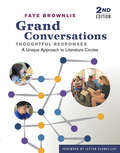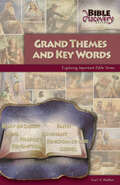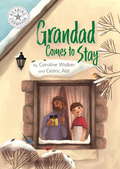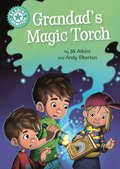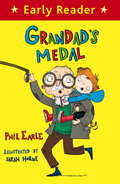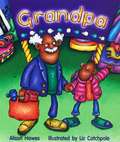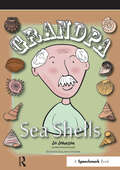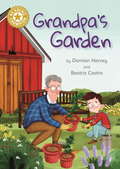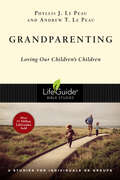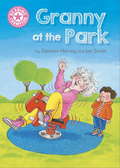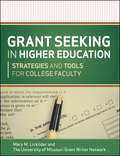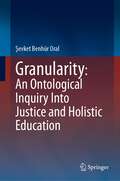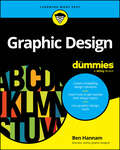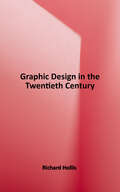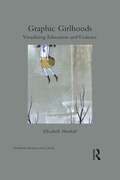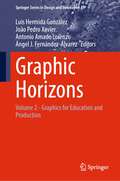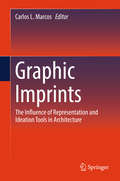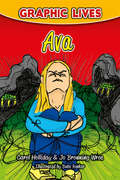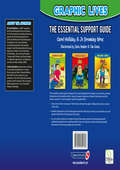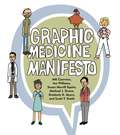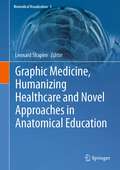- Table View
- List View
Grand Conversations, Thoughtful Responses: A Unique Approach to Literature Circles
by Faye BrownlieGrand Conversations, Thoughtful Responses is built upon the premise that all students can become active, independent, thoughtful readers. The structures and strategies in this book are proven to help students develop confidence and competence in their reading. Student engagement with text soars through participation in grand conversations with peers and reflecting on reading with thoughtful, written responses. This unique approach includes:student choice in booksstudents reading at their own pace, thus creating flexible groupsliterature circles where students discuss the shared text they are readingstrategies for teaching written responsestrategies for co-creating assessment criteriaadditional activities to develop and deepen comprehensionbook listsThis new edition has been expanded to include examples and book lists for grades K to 12.
Grand Themes And Key Words: Exploring Important Bible Terms (Bible Discovery Series)
by Karl A WaltherLet's face it—sometimes the Bible is confusing. When reading the Bible, have you ever come across words or ideas that are difficult to understand? There are many complex words and themes in Scripture. It can be hard to keep track of them all, especially in their proper context. Grand Themes and Key Words is a book that will give you a more thorough understanding of God's Word by defining these elements and arranging them alphabetically with a dictionary-like layout, making it a great tool that you can keep close at hand while reading the Bible. Themes and Key Words include: Abraham's Children The Angel of the Lord Covenant Gospel Grace Kingdom of God Light and Darkness Names Redemption Seven Water Yeast Zion And many more! This book is part of the Bible Discovery Series, which provides you with background resources to help you unearth and understand the Bible's greater meaning for your life today!
Grandad Comes to Stay: Independent Reading White 10 (Reading Champion #697)
by Caroline WalkerOliver loves to RUN and he never sits still or moves slowly ... until an injury forces him to take it easy. Lucky for Oliver, Grandad comes round to help, and he is full of great ideas to have fun during Oliver's slow winter! This book is aimed at Independent Reading Book Band White 10, for readers aged from 5-7 years.This story is part of Reading Champion, a series carefully linked to book bands to encourage independent reading skills, developed with Dr Sue Bodman and Glen Franklin of UCL Institute of Education (IOE).Reading Champion offers independent reading books for children to practise and reinforce their developing reading skills.Fantastic, original stories are accompanied by engaging artwork and a reading activity. Each book has been carefully graded so that it can be matched to a child's reading ability, encouraging reading for pleasure.
Grandad's Magic Torch: Independent Reading Turquoise 7 (Reading Champion #691)
by Jill AtkinsThe children are on a camping holiday with Mum and Grandad. And when Grandad lends them his torch, the adventure really begins!Reading Champion offers independent reading books for children to practise and reinforce their developing reading skills.Fantastic, original stories are accompanied by engaging artwork and a reading activity. Each book has been carefully graded so that it can be matched to a child's reading ability, encouraging reading for pleasure.Independent Reading Turquoise 7 stories are perfect for children aged 5+ who are reading at book band 7 (Turquoise) in classroom reading lessons.
Grandad's Medal (Early Reader)
by Phil EarleEarly Readers are stepping stones from picture books to reading books. A blue Early Reader is perfect for sharing and reaading together. A red Early Reader is the next step on your reading journey.Marvin loves going on his adventures with his grandad - escaping from hairy yetis, taking daytrips to Mars, and hunting ferocious tigers - all without leaving the house. Marvin thinks his grandad is the bravest person he's ever met; he even has a medal from the war to prove it. And, more than anything else, Marvin wants to be brave too.But when Grandad must go on his final adventure alone, Marvin finds he has to be braver than he's ever been before. Until he discovers that Grandad has left behind a very special surprise just for him . . . A touching and poignant Early Reader story, perfect for children coming to terms with grief for the first time.
Grandma's Santo on Its Head / El santo patas arriba de mi abuelita: Stories of Days Gone By in Hispanic Villages of New Mexico / Cuentos de días gloriosos en pueblitos hispanos de Nuevo México
by Nasario García&“Children and adults alike will enjoy Nasario&’s brilliant telling of the events that were part of his growing up. As I read the stories I heard Nasario&’s voice and I could see clearly the people and places he describes. I was reminded that the stories our grandparents told not only entertained us, they taught us valuable lessons.&“The magic of storytelling is still with us. At home or in the classroom, stories such as these will spark the imagination and encourage reading.&”—Rudolfo Anaya, author of Bless Me, UltimaThe popular cuentos that parents and grandparents in rural New Mexico once upon a time told their children are a rich source of the folklore of the region and offer satisfying entertainment. In this collection of bilingual stories about the Río Puerco Valley, where Nasario García grew up, he shares the traditions, myths, and stories of his homeland. He recounts stories of the evil eye and rooster racing, the Wailing Woman and the punishing of the santos. Preceding each tale is García&’s brief explanation of the history and culture behind the story.
Grandpa (Into Reading, Level E #3)
by Alison Hawes Liz CatchpoleNIMAC-sourced textbook <P><P>Lexile Measure: 150L
Grandpa Seashells
by Jo Johnson'Grandpa Sea Shells' tells the story of three young children who spend a day with their grandparents after their grandfather has been diagnosed with dementia. The book is intended to support conversation at the time of first changes in a relative, a diagnosis of dementia and mild to moderate progression. Families and clinicians have told us this is the time period when they need material to support their explanations to children. Whilst the book could be used to start a conversation about any form of dementia, most of the key symptoms described in this story reflect the typical features associated with the Alzheimer's type, as this continues to be the most common. This book has been designed so that children of between four and ten can read it independently. Ideally it should be used with an adult to facilitate discussion about all aspects of family life and to enhance general emotional wellbeing. The book deliberately makes dementia one of many things going on for this family and highlights things that families can still enjoy together. We have included ideas for positive activities at the end of the book as well as puzzle and description pages that children can enjoy doing with a family member, teacher or clinician.
Grandpa's Garden: Independent Reading Gold 9 (Reading Champion #657)
by Damian HarveyThis story is part of Reading Champion, a series carefully linked to book bands to encourage independent reading skills, developed with Dr Sue Bodman and Glen Franklin of UCL Institute of Education (IOE).In this family story, Sam just wants to play his game. He really doesn't want to spend time gardening with his grandpa. But he is soon excited about the growing beans.Reading Champion offers independent reading books for children to practise and reinforce their developing reading skills.Fantastic, original stories are accompanied by engaging artwork and a reading activity. Each book has been carefully graded so that it can be matched to a child's reading ability, encouraging reading for pleasure.e.
Grandparenting: Loving Our Children's Children (LifeGuide Bible Studies)
by Phyllis J. Le Peau Andrew T. Le Peau®
Granny at the Park: Independent Reading Pink 1B (Reading Champion #92)
by Damian HarveyReading Champion offers independent reading books for children to practise and reinforce their developing reading skills.Fantastic, original stories are accompanied by engaging artwork and a reading activity. Each book has been carefully graded so that it can be matched to a child's reading ability, encouraging reading for pleasure.Independent Reading Pink 1B stories are perfect for children aged 4+ who are reading at book band 1B (Pink) in classroom reading lessons.In this story, Granny loves the park - even more than her grandson!
Grant Seeking in Higher Education
by Mary M. Licklider The University of Missouri Grant Writer NetworkGrant funding has become increasingly crucial to universities and university faculty, even as government and private funding reductions and increased application pools result in a more and more competitive environment. Securing the funding which is available is not a simple process, and institutional support for faculty who seek grants is uneven, where it exists at all. Faculty members are often left to navigate their own ways through the shifting landscape of the grants maze. When added on top of teaching and service loads, it's no surprise that many faculty members either avoid seeking grants altogether or produce grant proposals which have little or no chance of being funded.Faculty need a guide, and this book is that guide.Written by a team of successful grant writers, Grant Seeking in Higher Education orients faculty to the grants culture and walks readers step-by-step through the entire grant-seeking process, from identifying sources to preparing a successful application to administering the funds after the grant is awarded. The grant-seeking toolkit--which is free online to purchasers of the book for you to download or print and use in your work--includes standard forms, templates, and timelines for proposal development so any faculty member, from the scientist to the humanities scholar, can be sure not to miss out on the funding they deserve.
Granularity: An Ontological Inquiry Into Justice and Holistic Education
by Şevket Benhür OralThis book presents an original exploration of philosophical questions pertaining to the ways we grasp the Absolute by bringing together the Buddhist notion of interpermeation of all phenomena into contemporary strains of thought in continental philosophy. This text introduces an ontological concept, granularity, deploying it to probe questions concerning the intersection of ontology, ethics, and education. A wide range of issues in metaphysics are covered—including being, nothingness, unity, plurality, truth, change, transformation, subjectivity, contradiction, coherence, potentiality—from the perspective of thinkers such as Hegel, Heidegger, Badiou, Meillassoux, Malabou, Žižek, and Harman. The text deploys granularity in arguing for an ethics of unconditional hospitality within education. This volume is intended for students and researchers working in the areas of philosophy of education, philosophy of religion, and continental philosophy.
Grapefruit Basket Upset
by Nancy Simpson LeveneAlex feels guilty when she and her girlfriends break the rules to win the Sunday school contest.
Graphene
by Mikhail I. KatsnelsonGraphene is the thinnest known material, a sheet of carbon atoms arranged in hexagonal cells a single atom thick, and yet stronger than diamond. It has potentially significant applications in nanotechnology, 'beyond-silicon' electronics, solid-state realization of high-energy phenomena and as a prototype membrane which could revolutionise soft matter and 2D physics. In this book, leading graphene research theorist Mikhail Katsnelson presents the basic concepts of graphene physics. Topics covered include Berry phase, topologically protected zero modes, Klein tunneling, vacuum reconstruction near supercritical charges, and deformation-induced gauge fields. The book also introduces the theory of flexible membranes relevant to graphene physics and discusses electronic transport, optical properties, magnetism and spintronics. Standard undergraduate-level knowledge of quantum and statistical physics and solid state theory is assumed. This is an important textbook for graduate students in nanoscience and nanotechnology and an excellent introduction for physicists and materials science researchers working in related areas.
Graphic Design For Dummies
by Ben HannamThe complete, full-color graphic design guide for beginners The field of graphic design is constantly evolving, with new design tools, methods, technology, and modes of expression being introduced all the time. Graphic Design For Dummies will teach you how to get started, introducing you to basic design principles as well as the latest best practices, software, and trends. You'll learn how to successfully plan and execute compelling design projects, even if you're not a trained designer. This fun and friendly book will empower you with the information you need to create design solutions. You'll also have the opportunity to test your skills with a series of interactive design activities, starting with step-by-step guidance and slowly building up your skills until you're ready to fly solo. Unleash your inner graphic designer with this Dummies guide. Create compelling visuals for a wide range of tasks and purposes Learn the basic concepts of graphic design and get the tools you need to start Get hands-on experience by following tutorials to create great designs Become proficient in graphic design—no art degree needed Graphic Design For Dummies is a practical and user-friendly resource for those looking to create better design solutions quickly.
Graphic Design in the Twentieth Century: A Concise History (World of Art)
by Richard HollisA new edition of a seminal book on the history of graphic design in the twentieth century by one of the leading authorities in the field. The story of graphic design is one of the most exciting and important developments in twentieth-century visual culture. From its roots in the expansion of printing, graphic design has evolved from a means of identification, information, and promotion to a profession and art in its own right. This authoritative documentary history begins with the poster and goes on to chart the use of text and image in brochures and magazines, advertising, corporate identity, television, and electronic media, and includes the effects of technical innovations such as photography and the computer, as well as the digital revolution. With over eight hundred illustrations fully integrated with the text, this indispensable account is uniquely clear, comprehensive, and absorbing. For this latest edition, Graphic Design in the Twentieth Century has been updated with a new preface and additions to the bibliography, ensuring its continued usefulness to students and designers alike.
Graphic Girlhoods: Visualizing Education and Violence (Children's Literature And Culture Ser.)
by Elizabeth MarshallDrawing on a dynamic set of "graphic texts of girlhood," Elizabeth Marshall identifies the locations, cultural practices, and representational strategies through which schoolgirls experience real and metaphorical violence. How is the schoolgirl made legible through violence in graphic texts of girlhood? What knowledge about girlhood and violence are under erasure within mainstream images and scripts about the schoolgirl? In what ways has the schoolgirl been pictured in graphic narratives to communicate feminist knowledge, represent trauma, and/or testify about social violence? Graphic Girlhoods focuses on these questions to make visible and ultimately question how sexism, racism and other forms of structural violence inform education and girlhood. From picture books about mean girls The Recess Queen or graphic novels like Jane, The Fox and Me to Ronald Searle's ghastly pupils in the St. Trinian's cartoons to graphic memoirs about schooling by adult women, such as Ruby Bridges's Through My Eyes and Lynda Barry's One Hundred Demons texts for and about the schoolgirl stake a claim in ongoing debates about gender and education.
Graphic Horizons: Volume 2 - Graphics for Education and Production (Springer Series in Design and Innovation #43)
by João Pedro Xavier Luis Hermida González Antonio Amado Lorenzo Ángel J. Fernández-ÁlvarezThis book reports on several advances in architectural graphics, with a special emphasis on education, training, and architectural production. It gathers a selection of contributions to the 20th International Congress of Architectural Graphic Expression, EGA 2024, held on May 27-29, 2024, in Porto, Portugal, with the motto: "Graphic Horizons". This is the second of a 3-volume set.
Graphic Imprints: The Influence Of Representation And Ideation Tools In Architecture
by Carlos L. MarcosThis is the Proceedings of the International Congress of Graphic Design in Architecture, EGA 2018, held in Alicante, Spain, May 30-June 1, 2018. About 200 professionals and researchers from 18 different countries attended the Congress. This book will be of interest to researchers in the field of architecture and Engineering. Topics discussed are Innovations in Architecture, graphic design and architecture, history and heritage among others.
Graphic Lives: A Graphic Novel for Young Adults Dealing with an Eating Disorder (Graphic Lives)
by Carol Holliday Jo Browning Wroe Angeleen RenkerGraphic Lives is a series of highly engaging graphic novels for young people who may need counselling and psychotherapy. Each book introduces the difficulties faced by a teenage character and follows them as they travel on their therapeutic journey with a skilled and creative therapist. The key aims of these books are: to demystify counselling and psychotherapy so that it is more appealing and accessible to young people; to destigmatise emotional and mental health problems so that young people are better able to accept help; to encourage young people to embark upon their own healing journeys, equipped with the sense that there is a way forward. Sixteen year-olds Ava and Jade are obsessed with food, calories, and staying thin. Pleased with the many compliments they receive they push themselves into anorexia. Ava's mother is alarmed by her daughter's weight loss and forces her into therapy with the school counsellor, Steph. However after only two sessions Steph touches a raw nerve, Ava storms out and refuses to continue. Only when Jade is admitted to hospital does Ava return to therapy, where she begins to understand the causes of her anorexic tendencies.
Graphic Lives: Essential Support Guide (Graphic Lives)
by Carol Holliday Jo Browning WroeGraphic Lives is a series of highly engaging graphic novels for young people who may need counselling and psychotherapy. Each book introduces the difficulties faced by a teenage character and follows them as they travel on their therapeutic journey with a skilled and creative therapist. The key aims of these books are: to demystify counselling and psychotherapy so that it is more appealing and accessible to young people; to destigmatise emotional and mental health problems so that young people are better able to accept help; to encourage young people to embark upon their own healing journeys, equipped with the sense that there is a way forward. The essential support guide, designed to be used alongside the Graphic Lives novels, provides therapists and counsellors with a range of support resources, linked to the stories and the issues covered. For each graphic novel, this guide offers: clear and concise coverage of risk factors and warning signs relating to the issue covered in the story; detailed exploration of each therapeutic session in the story so that you can devise you own sessions that link to the therapy in the story; an up-to-date summary of research around the issue covered in the book along with professional guidance on working with that issue to help you achieve the best possible outcomes for the young people you work with.
Graphic Medicine Manifesto (Graphic Medicine #1)
by Ian Williams Michael J. Green Susan Merrill Squier Scott T. Smith MK Czerwiec Kimberly R. MyersThis inaugural volume in the Graphic Medicine series establishes the principles of graphic medicine and begins to map the field. The volume combines scholarly essays by members of the editorial team with previously unpublished visual narratives by Ian Williams and MK Czerwiec, and it includes arresting visual work from a wide range of graphic medicine practitioners. The book’s first section, featuring essays by Scott Smith and Susan Squier, argues that as a new area of scholarship, research on graphic medicine has the potential to challenge the conventional boundaries of academic disciplines, raise questions about their foundations, and reinvigorate literary scholarship—and the notion of the literary text—for a broader audience. The second section, incorporating essays by Michael Green and Kimberly Myers, demonstrates that graphic medicine narratives can engage members of the health professions with literary and visual representations and symbolic practices that offer patients, family members, physicians, and other caregivers new ways to experience and work with the complex challenges of the medical experience. The final section, by Ian Williams and MK Czerwiec, focuses on the practice of creating graphic narratives, iconography, drawing as a social practice, and the nature of comics as visual rhetoric. A conclusion (in comics form) testifies to the diverse and growing graphic medicine community. Two valuable bibliographies guide readers to comics and scholarly works relevant to the field.
Graphic Medicine Manifesto (Graphic Medicine)
by Ian Williams Michael J. Green Susan Merrill Squier Scott T. Smith MK Czerwiec Kimberly R. MyersThis inaugural volume in the Graphic Medicine series establishes the principles of graphic medicine and begins to map the field. The volume combines scholarly essays by members of the editorial team with previously unpublished visual narratives by Ian Williams and MK Czerwiec, and it includes arresting visual work from a wide range of graphic medicine practitioners. The book’s first section, featuring essays by Scott Smith and Susan Squier, argues that as a new area of scholarship, research on graphic medicine has the potential to challenge the conventional boundaries of academic disciplines, raise questions about their foundations, and reinvigorate literary scholarship—and the notion of the literary text—for a broader audience. The second section, incorporating essays by Michael Green and Kimberly Myers, demonstrates that graphic medicine narratives can engage members of the health professions with literary and visual representations and symbolic practices that offer patients, family members, physicians, and other caregivers new ways to experience and work with the complex challenges of the medical experience. The final section, by Ian Williams and MK Czerwiec, focuses on the practice of creating graphic narratives, iconography, drawing as a social practice, and the nature of comics as visual rhetoric. A conclusion (in comics form) testifies to the diverse and growing graphic medicine community. Two valuable bibliographies guide readers to comics and scholarly works relevant to the field.
Graphic Medicine, Humanizing Healthcare and Novel Approaches in Anatomical Education (Biomedical Visualization #3)
by Leonard ShapiroThis book contains subjects by authors with a fresh, exciting and extensive focus within the medical humanities, offering the reader chapters which include the history of medical illustration, Graphic Medicine as a vehicle for the expression of humanistic dimensions of healthcare, equitable and ethical medical illustrations, as well as novel, art-based approaches in anatomical education. Authors consider the role of visual narratives in medical and scientific illustration, the unique affordances of the comics medium, the history of comics as a form of medical and scientific visualization, and the role of comics as didactic tools and as vehicles for the expression of the humanistic dimensions of healthcare. A chapter considers ethical and equitable implications in global healthcare practice, and highlights the work currently being undertaken to address inappropriate and problematic depictions of people in global health visualizations. This will inform the reader of emerging and current thinking about visual communication and the use of images in the public domain, as well as in the healthcare and education sectors. Novel approaches in anatomical education include the benefits of three-dimensional anatomy models made of felt, visual analogies as a method to enhance students’ learning of histology, the use of the hands for learning anatomy, and visualizing anatomy through art, archaeology and medicine. This book will appeal to readers who have an interest in the medical humanities, Graphic Medicine, and ethical medical and anatomical illustrations. These include academic and non-academic readers, medical students, medical educators, clinicians, health-care workers, as well as policy makers.
